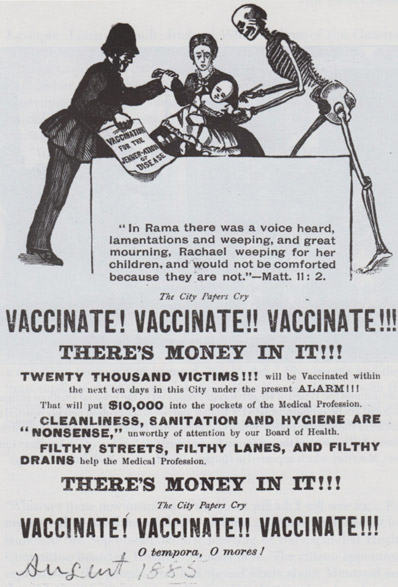Εδώ θά φρίξετε μέ τήν Ιστορία εμβολιασμών καί τά Αντιεμβολιστικά Κινήματα. Άρθρον 26 Οκτωμβρίου 2016 μ.Χ.!…. Τό κόλπον είναι παλαιόν καί επαναλαμβανόμενον, επιβεβαίωνεται τό 10ον κεφ. Πρωτόκολλων τής Σατανώ
ΘΑΝΑΤΟΣ Ο ΕΜΒΟΛΙΑΣΤΗΣ!
Κάποτε σάς έγραψα διαβάζετε τί έκαναν οί Έλληνες νά επιβιώσουν τόν Μεσαίωνα καί μέ τί ευφυία Αγωνίζονταν σέ Αγώνες γενικευμένους καί καθημερινούς που ξεπερνάνε καί τούς Αρχαίους Έλληνες. Έκαμα λάθος διότι έπρεπε νά σάς ειπώ διαβάστε όλον τόν Μεσαίωνα, αλλά δύσκολα θά πιστεύσω ότι δέν τό έγραψα, ώστε νά μπορείς νά είσαι ένας καθώς πρέπει Αυταρκής καί Ευσεβής πρός Τόν Θεόν που σού παραχωρεί τήν Ευλογία τής Αυτάρκειας Πρωτόγονος…
Death, The Vaccinator
October 26, 2016 carleyroche
Today’s blog post is by Carley Roche, History of Vaccines intern
During the month of October, we see pumpkins, black cats, witches, and skeletons everywhere we turn. These images remind us of costumed children, scary movies, and tasty treats. But there is a bigger history behind these images, specifically the skeleton. A symbol for death and the afterlife, sometimes positive and sometimes negative, the skeleton holds a powerful meaning across many diverse cultures. It was also once adopted by the 19th-century anti-vaccination movement to scare people, especially parents, into forgoing smallpox vaccination. Below are a few examples of skeletal images used by Victorian Era anti-vaccinators.
Image from a Victorian Era anti-vaccination journal depicting death waiting to vaccinate a young child.
Death The Vaccinator
In 1853 the Anti-Vaccination League was founded in London as an immediate response to the Vaccination Act of the same year, which called for compulsory vaccination for all infants in the first three months of life. Parents who did not follow suit were liable to a fine or imprisonment. Here we see a police officer reminding a mother to vaccinate her young child, while a skeleton (death) is touching the child where the vaccine is routinely injected. The League and other anti-vaccination groups used images in pamphlets and their own journals as a common and easy way to get the public’s attention to the League’s belief that the vaccines caused more harm than good.
An envelope showing death vaccinating a young child and a mother being held back by a police officer allowed for anti-vaccinators to have their message spread far and wide.
Death The Vaccinator, Envelope
Victorian anti-vaccinators were very creative in their propaganda tools. Here is an envelope showing a scene similar to the Death the Vaccinator image. The envelope also has a short message written on the flap stating, “Vaccination is a process of corruption and death” and also warns that vaccinating doctors have only financial gain in mind. Utilizing envelopes allowed for a broader audience to receive the anti-vaccination message.
A poster used in Montreal to convince the general public that the government and medical professionals were only vaccinating children for monetary gain and not for health reasons.
There’s Money In It!!!
The exact same image from the envelope, minus the coloring, appears in this 1885 poster from the city of Montreal, Quebec, Canada. It was not only the United Kingdom with grand scale anti-vaccination movements during this era, but also Canada, the United States, and Brazil. Appealing to the working class, these posters claimed the government and medical professionals only wanted to make money from vaccinating children. Anti-vaccinators stated that “cleanliness, sanitation, and hygiene” would be enough to keep the body safe from infectious diseases and that the new science of vaccination would instead cause bodily and economic harm.
A political cartoon from famous Punch magazine lauding the passing of the 1898 Vaccination Act (U.K.) while also warning of the public’s upset that their individual liberty is being threatened due to government interference.
Triumph of De-Jenner-Ation
Political cartoons were popular during the early 19th century in Western Europe and North America, especially among the middle class. Here is a cartoon from the popular Punch magazine depicting the reaper victoriously holding up a copy of the United Kingdom’s 1898 Vaccination Act and a snake ready to attack in the bottom corner. Unlike other portrayals of skeletons in imagery related to the vaccination debate, this one supports the Act, which legalized compulsory smallpox vaccination, though it included a conscientious objection clause. The debate between individual liberty vs. social good appears in this image with the snake representing individual liberty (preventable diseases ready to strike future generations due to those refusing vaccinations) while the reaper represents social good (the elimination of preventable diseases through government orders and the public’s acceptance). The title “Triumph of De-Jenner-Ation” nods, of course, to Edward Jenner, the pioneer of the smallpox vaccine.
A political cartoon that does not have the skeleton as the main focus anymore. A snake, representing vaccination, is ready to strike a mother and her young child instead.
Do Not Vaccinate!!!
A scared mother holding her helpless child flees from a giant snake as a skeleton watches and waits in the background. In a simple yet stirring cartoon the anti-vaccination movement uses fear to gain favor for their ideals. Telling its viewers with fewer than five words that death awaits for those who vaccinate shows just how well-known the anti-vaccination movement’s argument was by the late 1800s. While the skeleton is no longer Death The Vaccinator he is still the depiction of death incarnate in the eyes of anti-vaccinators.
A creature of mixed animal parts creates The Vaccination Monster, who is a beast with an insatiable appetite for young children. The horned men feeding the monster are seen as followers of pro-vaccination.
The Vaccination Monster
A bonus image, one without skeletons, shows the vaccination monster. He is a creature of mixed animals with “all the evils of Pandora’s box in his belly, plague pestilence, leprosy, purple blotches, foetid ulcers, and filthy running sores covering his body.” Anti-vaccinators once again use fear as a ploy to convince the public to join their movement by depicting horned medical professionals feeding babies to the monster to help feed its unending appetite. Anti-vaccinators wanted to portray vaccinating doctors and parents as worshipers of a disease cult who were putting children in the jaws of danger, quite literally here.
Death The Vaccinator was a powerful image during the 19th century, inciting fear and anger amongst the general public. The anti-vaccination movement went to extreme measures to “protect” their children, even going so far as to create fake vaccination scars and falsified vaccination certificates so unvaccinated children could still attend school, thus endangering their lives and the lives of other children. When comparing the Victorian Era anti-vaccination movement with the modern day one there is not much difference in tactics used with the main tool being to induce fear through imagery. Only the medium used to spread these ideas has changed as technology has entered our daily lives. The images here use similar tactics as in the Victorian Era by inducing fear with the image of a scared and hurt child. Death The Vaccinator, once the mascot of the anti-vaccination movement, is not physically seen anymore, but his presence is still felt in the ads, images, and articles published by modern anti-vaccinators.
Modern anti-vaccination movements use similar tactics as Victorian anti-vaccination movements to get their message out such as using envelopes with fearsome images. The anti-vaccination movement today uses fear tactics much like the original anti-vaccination groups.
All historical images are from The College of Physicians of Philadelphia’s Historical Medical Library and copyright The College of Physicians of Philadelphia. With exception of Triumph of De-Jenner-Ation copyright Punch Magazine,The Vaccination Monster of public domain, and Do Not Vaccinate!!! of public domain.
Reference List
The American Anti Vaccination Society (est. 1885). Science & Story. February 7, 2015. https://jeneeninterlandi.com/2015/02/07/the-american-anti-vaccination-society-est-1885/ Accessed October 5, 2016.
Smallpox. Museum of Health Care at Kingston. 2016. http://www.museumofhealthcare.ca/explore/exhibits/vaccinations/smallpox.html Accessed October 5, 2016.
Personifying Pestilence: How Political Cartoons Shape Our Views of Disease. ActiveHistory.CA. April 1, 2015. http://activehistory.ca/2015/04/personifying-pestilence-how-political-cartoons-shape-our-views-of-disease/ Accessed October 5, 2016
Wolfe RM, Sharp LK. Anti-vaccinationists past and present. The British Medical Journal. 2002 Aug 24; 325(7361): 430-432. doi http://dx.doi.org/10.1136/bmj.325.7361.0.
The Victorian Anti-Vaccination Movement. The Atlantic. July 15, 2015.
http://www.theatlantic.com/health/archive/2015/07/victorian-anti-vaccinators-personal-belief-exemption/398321/ Accessed October 12, 2016.
https://www.historyofvaccines.org/Death-The-Vaccinator Κλίκαρε στό άρθρον αυτόν νά δείς τίς φωτογραφίες καί τίς αφίσσες τής εποχής τότες!!!!
ΠΑΝΑΓΙΩΤΗΣ ΔΙΑΣ
Επιλεξτε να γινετε οι πρωτοι που θα εχετε προσβαση στην Πληροφορια του Stranger Voice





